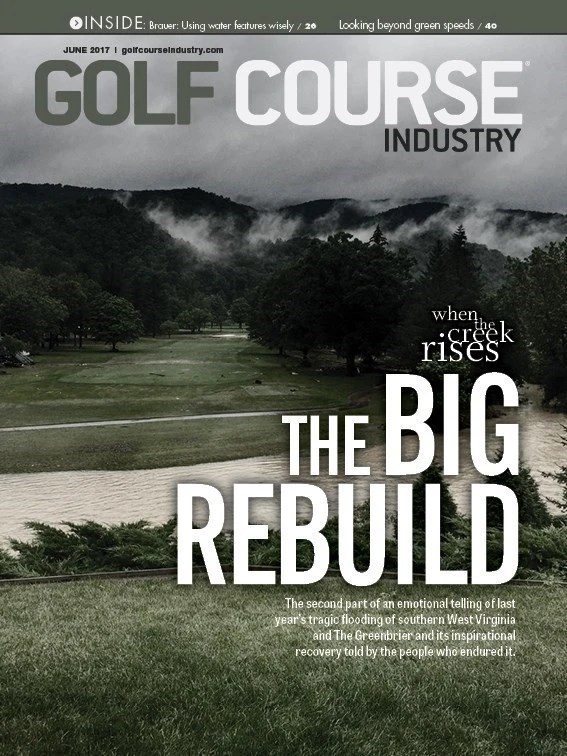As if you needed any more proof that I am an old fart, consider this: 2017 marks my 30th anniversary of “working” in this crazy little industry. I was 25 when the nice folks at GCSAA hired me to be a reporter for GCM in 1987. I turned 55 a few months ago and I’m still shocked that I get paid to do any of this.
People ask how many articles and columns I’ve written over three decades. I honestly have no clue. Maybe 600-700? I’ve been to 29 GCSAA/GIS shows (I missed 1997). I’ve given at least 250 talks along the way. I’ve visited nearly 700 golf courses, including about 85 of the Golf Digest Top 100. And I’ve attended about 80 professional golf events, including 35 majors, Ryder Cups and President’s Cups.
Much has changed in 30 years but the way we host and conduct major championships and other big televised events has evolved most dramatically. It’s gone from bringing back a few former workers and friends (ala Paul Latshaw the Elder who pioneered the idea) to a literal army of workers, including staff, former staff, buddies, local volunteer supers, out-of-state volunteer supers, and, of course, ambitious assistants and students looking to add “major championship experience” to their resumes.
The concept is simple. The host superintendent gets several thousand hours of free labor and expertise in exchange for the experience of being part of a major championship. For many, it’s a transactional thing: I will come work at your golf event so I can tell potential employers I’ve worked at a major. For others, there are less tangible but even more important benefits to volunteering. I’ll come back to that in a bit.
The championship agronomy team concept has also grown into a logistical monster. It takes a lot of work and money to organize, feed, shelter and clothe 100+ folks for a weeklong event. (Imagine Pinehurst with back-to-back Men’s and Women’s Opens stretching over two weeks.) In the old days, you just showed up to work and maybe you could sleep in the maintenance facility or share a cheap hotel room with six other guys. You might get a hat or shirt if you were lucky.
Today, there is housing, uniforms, catered meals, entertainment and swag galore. And that all costs a lot. Consider for a moment that one volunteer for a big event will usually be on site for a week (five hotel nights), needs at least three shirts, jackets, hats and other stuff, and gets fed three squares a day. When you add it all up, each of those free volunteers actually costs a thousand dollars or so.
Who pays for that stuff? Well, it’s mostly the same industry leaders who sponsor and underwrite a lot of what we do in our community. The Big 3 iron manufacturers, the big chemical and fertilizer companies, and the distributors who serve the course itself. I’ve talked with a lot of them and, increasingly, they’re being asked to write five-figure checks (or otherwise ante up) for tournament support. The thinking is it’s a great opportunity to support an important customer during their time in the spotlight …but they also get some time to impress and bond with those volunteers.
So, the big championship process has turned into big business for host courses, volunteers and the industry that serves it. That’s awesome … but sometimes the most important things get lost in the bigness. How?
Last month, I zipped down to visit my friend Mike Johnson of Vereens in Myrtle Beach and he was kind enough to take me up to Wilmington, N.C., to see a bit of the Wells Fargo Championship at the fantastic Eagle Point GC. I saw many superintendent and industry friends there, including, of course, the host super Craig Walsh. Since I was there, Craig decided to put me on the spot a little and say a few words to the 100 or so staff and volunteers gathered in the maintenance tent.
My message to those folks working their butts off to present a great course, get career experience and learn great things about our industry should also remember to do one more thing: Build great friendships.
The best thing I’ve learned about our business in the past 30 years is that friendships really, truly matter. I urged every one of those volunteers to use their time at the Wells Fargo event to make new friends, create relationships and build lifetime bonds. Yup, it’s great to have an event like that on your resume, but it’s even better to expand your circle of friends.
So, don’t get so caught up in your career or the demands of everyday life that you forget what really matters. It’s about the people. You’re never going to make a fortune doing this … but you can always get rich in friends.

Explore the June 2017 Issue
Check out more from this issue and find your next story to read.
Latest from Golf Course Industry
- Editor’s notebook: Green Start Academy 2024
- USGA focuses on inclusion, sustainability in 2024
- Greens with Envy 65: Carolina on our mind
- Five Iron Golf expands into Minnesota
- Global sports group 54 invests in Turfgrass
- Hawaii's Mauna Kea Golf Course announces reopening
- Georgia GCSA honors superintendent of the year
- Reel Turf Techs: Alex Tessman





